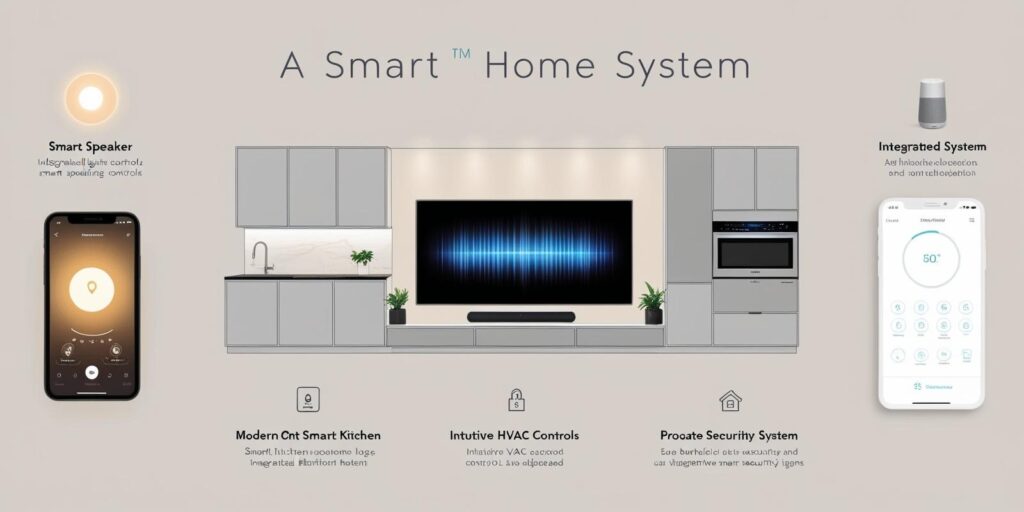The global Smart Home Market size accounted for USD 84.5 billion in 2024, grew to USD 89.8 billion in 2025 and is projected to reach USD 116.4 billion by 2029. . Another projection anticipates growth from USD 79.8 billion in 2023 to USD 428.9 billion by 2030, sustaining a similar CAGR of 27.16% . Clearly, smart home technologies—powered by AI and IoT—are spearheading this rapid expansion.
North America boasts the largest revenue share, while Asia-Pacific is forecasted to lead in growth rate, fueled by rising urbanization, affordability, and infrastructure development .
AI + IoT: Driving a Smarter, More Intuitive Home Experience
At the heart of this boom is the blending of artificial intelligence and Internet of Things—creating homes that are not just automated but intuitive. AI-driven devices now anticipate needs, manage environments, and enhance energy efficiency with minimal human input. A smart thermostat, for instance, learns your daily routines and adjusts temperatures automatically for comfort and cost savings .
Voice assistants like Amazon’s Alexa, Google Assistant, and Apple’s Siri have become the primary gateways into our smart living spaces, enabling homeowners to control lighting, temperature, and security with simple voice commands .
AI-enabled security systems are also evolving rapidly. Smart cameras and locks now distinguish between humans, pets, and objects, reducing false alarms and boosting automation—imagine your home unlocking as you approach based on proximity data .
Download PDF Brochure @ https://www.marketsandmarkets.com/pdfdownloadNew.asp?id=121

Interoperability: The Backbone of a Seamless Ecosystem
Despite advancements, device compatibility remains a critical challenge. Fragmented ecosystems can frustrate users. Standards like Matter—developed by major players including Amazon, Apple, Google, and the Connectivity Standards Alliance—are addressing this by ensuring devices from different brands communicate effortlessly, offer local control, and promise better security .
Recent updates to Matter (v1.4.2) are enhancing reliability, Wi-Fi-only onboarding, and router integration, while strengthening device authentication to guard against counterfeit gear—laying the foundation for smoother, safer smart home interactions .
Innovation in Practice: Real-World AI‑Enhanced Devices
Companies are pushing the envelope with AI-integrated home solutions. Samsung’s Bespoke AI line includes refrigerators and vacuums that optimize based on usage patterns, integrate via Knox security frameworks and trust chains, and deliver personalized experiences . LG’s ThinQ products leverage AI for voice control, activity recognition, and predictive automation across appliances . Google, too, is extending its AI capabilities into third-party devices like ADT and iRobot through Gemini‑enabled Home APIs, supporting seamless Matter compatibility and richer automation options .
Future Trajectory: From Smart to Autonomous Homes
The roadmap from today’s smart homes to tomorrow’s autonomous homes is already emerging. By 2030, homes are expected to self-manage HVAC, lighting, security, appliances, and even water systems without direct input—through integration of AI, edge computing, 5G/6G, and robotics .
Robotic companions—focused on eldercare and trustworthy automation rather than sci-fi humanoids—are gaining traction. Affordable, task-specific robots are enabling real-world usability and comfort . Neuromorphic computing is also making smart devices more responsive and energy-efficient, enabling always-on, local intelligent sensing in IoT devices and voice assistants .
Challenges: Security, Privacy, and Affordability
Despite compelling advantages, the smart home revolution faces headwinds. Security vulnerabilities are increasing: attacks on smart home devices surged by 124% in 2024, per cybersecurity reports . Privacy concerns persist, especially as homes become more data-rich. Repairability and sustainability of devices were also flagged as critical concerns at CES, signaling the need for more ethical, long-lasting designs . On the cost front, high initial investment and interoperability issues continue to deter some consumers from full adoption .
The Path Forward: Toward Truly Smart Living
The global smart home market is morphing rapidly thanks to AI and IoT integration. It’s shaping a future where homes don’t just respond but anticipate—enhancing convenience, improving energy efficiency, and bolstering security. Interoperability standards like Matter and advances in edge AI and robotics are laying the infrastructure for smart homes that feel intuitive and resilient.
As adoption rises across global regions, overcoming privacy and affordability challenges will be key. For consumers, developers, and investors alike, the smart home holds boundless opportunity—ushering in a new era where living spaces are dynamic, adaptive, and deeply personalized.
The key companies that offer smart home companies include Johnson Controls Inc. (Ireland), Honeywell International Inc. (US), Schneider Electric (France), Siemens (Germany), ASSA ABLOY (Sweden).
Smart Home Market FAQ
1. What is a smart home?
A smart home uses connected devices and systems—powered by IoT (Internet of Things) and AI (Artificial Intelligence)—to automate and enhance everyday tasks. This includes controlling lighting, temperature, security, entertainment, appliances, and more via voice, apps, or automation.
2. How big is the smart home market?
The global smart home market is growing rapidly, Smart Home Industry worth $116.4 billion by 2029. Factors such as rising urbanization, demand for energy efficiency, and consumer tech adoption are driving this surge.
3. What are AI-powered smart home devices?
These are devices that use machine learning and data analytics to learn user behaviors and automate tasks intelligently. Examples include:
- Smart thermostats that adapt to your routine
- AI-powered security cameras that detect specific objects or people
- Voice assistants that understand natural language commands
- Smart fridges and vacuums that optimize based on usage patterns
